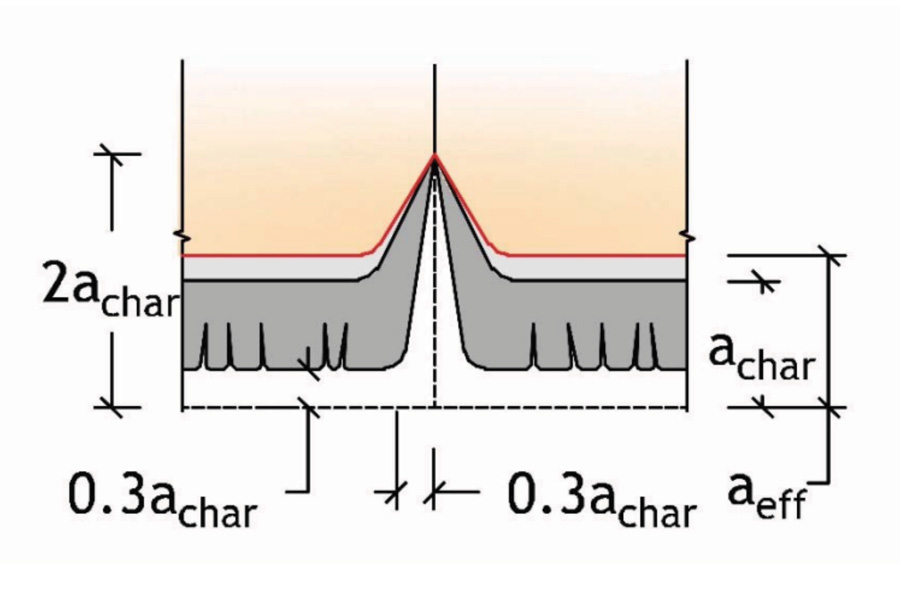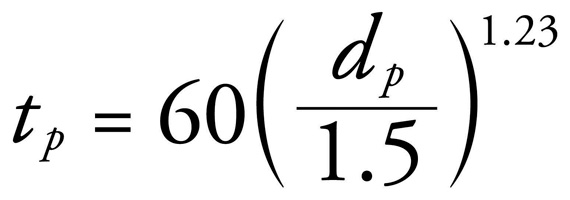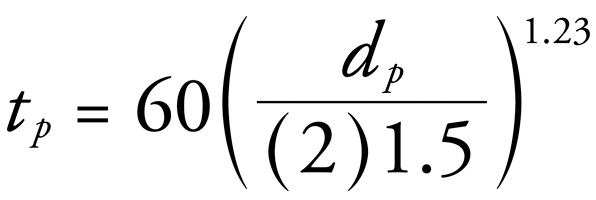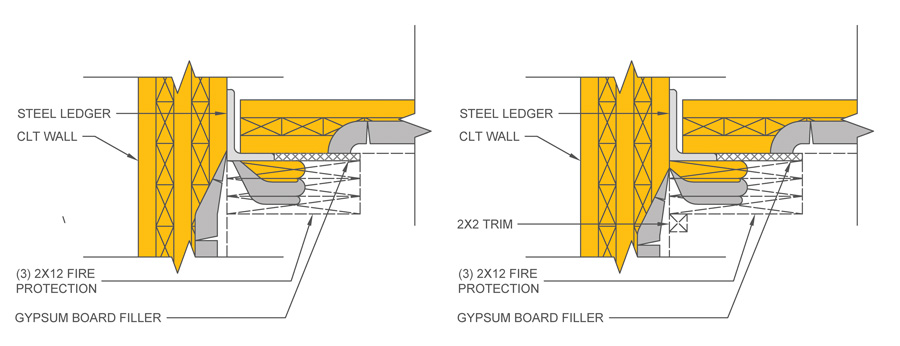It can be cost-effective to design wood structures for resilience and safety during fire events.
With growing public interest in sustainable building and with the addition of “mass timber” Construction Types IV-A, IV-B, and IV-C to the 2021 International Building Code (IBC), design professionals are increasingly required to design mass timber building elements to fire-resistance ratings prescribed by the IBC. While many members of the public, and even building design professionals at times, associate wood construction with inherent fire risks, it is feasible and can even be cost-effective to design wood structures for resilience and safety during fire events.
Specialty engineers and architects routinely handle fire protection design. This standard of design is effective and sensical for non-combustible structural materials as many commercially available products can be used to directly obtain a time-based fire-resistance rating. On the other hand, combustible materials, such as wood, used in building structures are not typically covered with sprayed fire-resistant materials and are often intentionally exposed for aesthetic purposes. The charring of a structural wood member, as well as the associated reduction of the member’s cross-section and material properties, necessitates the involvement of a structural engineer.
Chapter 16 of the American Wood Council’s (AWC) National Design Specification® for Wood Construction 2018 (NDS®) clearly outlines the procedure for calculating a fire-resistance rating for exposed wood members for up to 2 hours. However, the NDS offers only one paragraph of guidance for the fire protection design of wood connections. AWC’s newly published Fire Design Specification (FDS) for Wood Construction was approved as an ANSI standard on September 13, 2022 to fill this gap. The FDS is based largely on AWC’s Technical Report No. 10, Calculating the Fire Resistance of Wood Members and Assemblies (TR10), which supplements the NDS by providing summaries of research progress in the design of fire protection of wood elements, design procedures, and, most notably, design examples. The combination of NDS, FDS, and TR10 provides a well-supported and thorough means of designing fire protection of wood structural members and their connections for different fire ratings.
IBC Provisions
The 2021 IBC expanded Type IV construction to include three new subtypes and changed the previous Type IV to Type IV-HT. Type IV construction now consists of Type IV-A, Type IV-B, Type IV-C, and Type IV-HT, listed from greatest to least fire resistance. Type IV-HT typically does not require fire-resistance ratings for heavy timber elements unless these elements comprise exterior bearing walls or interior bearing walls supporting more than two floor/ceiling or roof/ceiling assemblies. Instead, inherent fire protection of heavy timber elements is achieved by requiring the use of prescriptive sizes found in Section 2304.11 of the IBC.
The differences between the new types of Type IV construction consist of required fire-resistance ratings (2021 IBC Tables 601 and 705.5), required non-combustible protection (2021 IBC Section 602.4), and limitations on building heights and areas (2021 IBC Chapter 5).
Fire Design of Wood Members
Using Chapter 16 of the NDS
In 2001, AWC first incorporated a chapter on fire design of wood members into the NDS. Chapter 16 of the NDS uses a mechanics-based approach for determining the fire resistance of exposed wood members for up to two hours. A reduced cross-section can be determined by calculating the amount of effective char a wood member develops over a specific fire exposure time. The reduced cross-sectional dimensions are, in turn, used to calculate a reduced member capacity that can be used to check for the controlling design limit under the appropriate load conditions. Although the section properties are reduced, the reference design values are still used as a starting point for design. These reference design values are multiplied by an adjustment factor specific to fire design as specified in NDS Table 16.2.2 to obtain average ultimate member strengths. When determining the adequacy of a member during fire exposure, it is only necessary to consider service level (allowable stress design) dead and live loads.
Introduction of the 2022 FDS
In September of 2022, AWC obtained ANSI approval for the 2022 FDS. The FDS incorporates the fire design provisions of the NDS and the fire design procedures within TR10 to provide a complete standard for the design of fire-resistance-rated wood members, assemblies, and connections.
While the NDS, FDS, and TR10 provide a methodology for the fire design of exposed structural members used as beams, columns, tension members, decking, floors, and walls, the remainder of this article focuses on the recommended design methodology for fire protection of wood member connections based primarily on the FDS.
Charring Behavior of Wood
To properly protect wood structural connections, one must first understand char depth, effective char depth, and char contraction. Wood members exposed to fire develop a char layer that extends into the member cross-section over an exposure time. This char layer can, in turn, act as an insulator for the member, slowing char growth over time. Due to the insulative properties of the char layer, a linear growth rate tends to underestimate char depth under short time frames and overestimate char depth under longer time frames.
To accommodate the insulative effect of the char layer, FDS, TR10, and NDS recognize a non-linear method of determining char depth as a function of the exposure time (FDS Equation 3.2-1, NDS Equation 16.2-2). Although these equations are applicable for most rectangular wood structural members, cross-laminated timber (CLT) manufactured with certain adhesives exhibits different char growth behavior due to the tendency for char to fall off as the char depth approaches the glue line. This fall-off behavior leads to a speed up and a slowdown of charring encompassed in different equations that consider the thickness of lamination layers and the time of fire exposure (AWC FDS Equation 3.2-5a, NDS Equation 16.2-3). New fire test protocols have been developed and are included in PRG 320-19, Standard for Performance-Rated Cross-Laminated Timber (referenced in 2021 IBC), to ensure adhesives used in CLT will not result in this behavior.
After calculating the approximate char depth, the FDS/NDS mandates a reduced member cross-section of 1.2 times the calculated char depth. This is called the effective char depth. For determining the fire-resistance rating of a structural member, this conservatively increased loss of structural section is all that is required. However, it becomes necessary to consider the effects of char contraction when unbonded members abut, such as at structural connections or where wood trim is used as an insulative protective layer.

As wood members exposed to fire begin to char, the charred wood shrinks such that the volume occupied by the charred member is less than the original volume of the wood before fire exposure. In fact, the actual thickness of char is approximately 70% of the calculated char depth. This gradual member shrinkage is termed char contraction. Char contraction plays a critical role in determining the fire protection of connections. For two abutting but unbonded members, the joint between the two members grows as char contraction occurs at the abutting corners. The gap that forms at the joint reveals the initially protected faces and allows ignition to occur increasingly at the location where the unbonded members meet. At these abutting edges, the FDS recommends using a depth of ignition into the formed gap of twice the calculated approximate char depth (Figure 1).
While the effects of char contraction can affect the strength of a member, they are more likely to expose structural components that, without extra protection, exhibit less fire resistance than required. For example, consider a wood beam and wood column connected by a steel ledger inserted into the beam. At the onset of a fire, the wood beam begins to char, but the ledger is not initially exposed. As char contraction occurs at the interface between the column and beam, the steel ledger is more quickly exposed to elevated temperatures than the calculated effective char depth would suggest.
Wood Member Connection Protection
Understanding char depths and char contraction make it possible to determine protection times for wood member connections. The FDS presents multiple ways to add time to the fire-resistance rating of wood structural members and to protect connections by adding sacrificial wood, type X gypsum board, or non-combustible materials such as mineral wool or fiberglass insulation. These materials can be used in combination, and their impacts on the fire-resistance times can be considered directly additive.
Fire protection of connections designed per the FDS is meant to provide thermal separation that meets the requirements of ASTM E119, which limits the average temperature rise on the unexposed side of the wood to 250°F over ambient and 325°F at any location. The newly added Section 2304.10.1 of the 2021 IBC, Connection Fire-Resistance Rating, also includes requirements consistent with ASTM E119. Due to steel’s high thermal conductivity, any structural steel connecting element used to fasten a primary structural element must be protected for the duration of the element’s fire-resistance rating to adhere to the ASTM E119 temperature rise limits. On the other hand, fasteners used to attach protection do not need protection themselves; they must be of sufficient length to ensure the protection stays in place for the required time.
The design of wood protection is discussed in FDS Section 3.3.1. For most instances, the protection time (tp) afforded by a layer of wood protection (thickness = dp) used to provide thermal separation for a connection can be determined by using FDS Equation 3.3-2; however, for the base layer of wood protection adjacent to the protected steel, Section 3.5.1 requires the results of Equation 3.3-2 to be modified by a 0.85 multiplier.
In areas where char contraction decreases the protection time of the connection, Equation 3.3-2, may be modified as shown to simplify the calculation of the fire protection time. When accounting for the effects of char contraction, the use of a 0.85 multiplier is not required by the FDS.
FDS Equation 3.3-2

FDS Equation 3.3-2 Modified for the Effects of Char Contraction

Consider the detail in Figure 2, where two similar fire protection designs are used to protect a CLT floor-to-wall connection. This detail shows the char pattern for a 90-minute exposure on each protection scheme (dark gray represents char). The design on the left incorrectly neglects the effects of char contraction; thus, the steel angle becomes exposed to increased temperatures prior to 90 minutes. The design on the figure’s right correctly protects against the effects of char contraction between the CLT wall and the 2×12 protection by adding a nominal 2×2 trim piece and successfully providing a 90-minute fire-resistance rating.

Type X Gypsum Board can also provide fire protection for wood structural members and connections. To establish a fire protection time with gypsum board, a designer should use Table 3.3.2.1 of the FDS. These values can be directly added when multiple layers of gypsum board are used to protect a structural member or connection. Type X gypsum board can be used for the protection of structural members and connections or, as it has been traditionally used, for the protection of structural assemblies such as a series of floor joists or wall studs.
The 2021 IBC requirements for using gypsum board as fire protection in mass timber construction types differ slightly from the provisions outlined in the FDS. For example, Table 722.7.1(2) of the 2021 IBC lists the protection time afforded by ½-inch type X gypsum board as 25 minutes which is more conservative than the 30 minutes allowed by the FDS (see FDS Table 3.3.2.1 excerpt in this article). Additionally, the 2021 IBC explicitly requires the use of non-combustible protection in mass timber construction types through Table 722.7.1(1) which allots a portion of the protection time for a specific fire-resistance rating that must come from non-combustible materials. There are also several specific requirements for fastening gypsum board fire protection in Section 722.7.2 of the 2021 IBC, which should be reviewed against the fastening requirements of the FDS during design.

For the base layer of thermal protection of the gypsum board, which is the layer adjacent to the steel being protected, the time of thermal separation shall equal the time of protection provided in FDS Table 3.3.2.1 multiplied by 0.50. It is important to note that gypsum board protection must be specially detailed per the footnotes to Table 3.3.2.1 to limit the effects of contraction and ensure the added protection time outlined in the table during a fire event. As mentioned, FDS Table 3.3.2.1 is excerpted in this article; however, many footnotes regarding construction requirements and protection time modifications have been omitted.

The FDS provides additional methods of adding to the fire-resistance rating of wood structural members and connections. Section 3.3.3 discusses non-combustible products such as mineral wool and fiberglass insulation and the impact these materials have on fire-resistance ratings. Similar to gypsum board protection, the determination of protection time from insulation can be determined prescriptively, in this case, FDS Table 3.3.3.1. This table provides additional protection times based on the type and thickness of insulation. Insulation protection times cannot be increased from their tabular values even with increased insulation thickness.
Conclusion
As the carbon-neutral and sustainable design market continues to grow, there is an increasing need for structural engineers who can design wood structures for the fire-resistance ratings required by the IBC. AWC’s NDS, FDS, and TR10 are excellent resources for engineers designing mass timber elements and their connections where fire-resistance-rated members and assemblies are required.■
